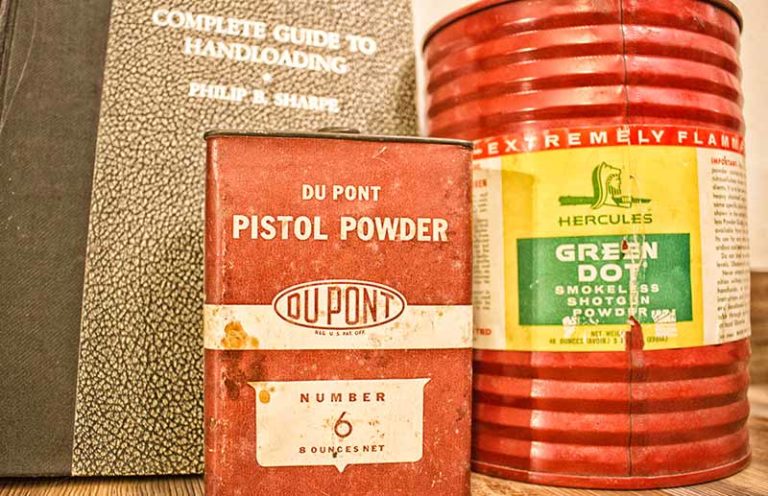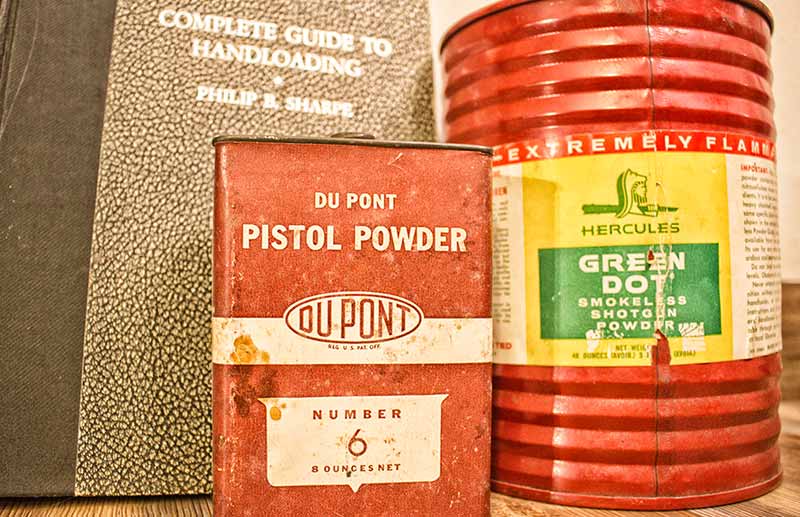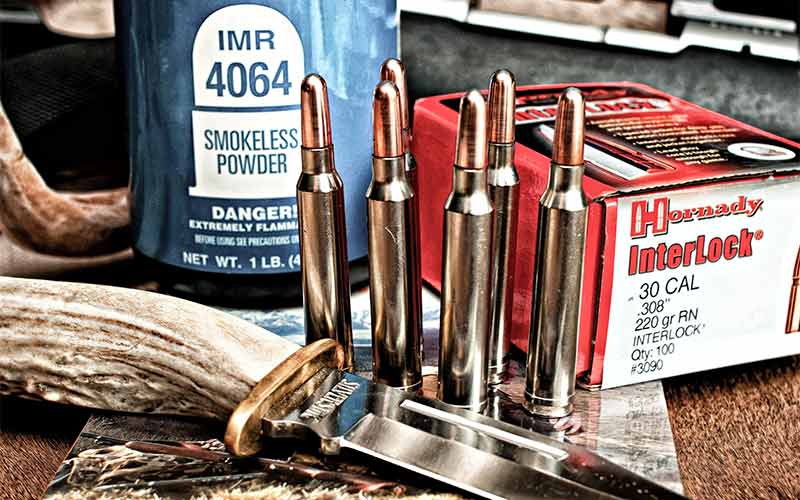
When it comes to reloading, do the classic powders still have a place? Or are you better off using something more modern?
It’s been a running joke that, for years, Ol’ Grumpy Pants adamantly insisted the .308 Winchester was all the cartridge needed, and furthermore, that cartridge should be loaded with 165-grain bullets and driven by IMR4064 powder. I still have my father’s notes in his Sierra Bullets Reloading Manual from the early 1970s. Handwritten in the back of the book was: “For .308, best all-around powder is IMR4064.”
That baby blue can was the only powder on the shelf—until I started to experiment with Hodgdon’s H380 and IMR 4320, garnering that look of disappointment from GP. When I insisted we try the then-new Varget from Hodgdon, he just shook his head and walked away.
He still prefers to use the older powders, probably because he learned their attributes years ago, and he’s never been big on change. I enjoy experimenting with new powders and have come up with some great recipes with the newer releases, like Alliant Reloder 16 and 23, the IMR Enduron line and Winchester’s new StaBall 6.5, but I still reach for those powders that have been with us for decades.
Those newer powders are packed full of innovative features, including chemical agents to help minimize copper fouling, and they’re the least temperature sensitive of any powders we’ve ever had. But that doesn’t mean the older powders are obsolete; in fact, they’re still perfectly viable.

The Names Have Changed
Powders do change, and if you look back at older reloading manuals, you may see unfamiliar powder brands and names. Alliant was once owned by Hercules, IMR was owned by DuPont and Winchester was proprietary. I have a copy of Philip B. Sharpe’s Complete Guide to Handloading from the 1950s, and he goes into detail about the common powders of the day, and when they were introduced.
Not only are a large number of the powders unfamiliar to me—DuPont had a series of pistol powders named by number, such as No. 1 and No. 5 that had been discontinued at the time of printing, but DuPont No. 6 was still in production—even so it gives great insight as to how rapidly the powder technology was changing in the first half of the 20th century.
Some of our most popular powders, like IMR 3031, IMR 4320 and GP’s beloved IMR 4064, came to us in the mid 1930s and were heralded for their low pressures (in comparison to earlier powders) and for their lack of tin, which caused fouling problems a century ago. IMR 4320 would go on to be the powder of choice for the earliest .308 Winchester factory ammunition as well as being a great choice for the .30-06 Springfield, .22-250 Remington and .375 H&H Magnum, but sadly has been discontinued.

However, IMR 3031, IMR 4895 and IMR 4064 remain not only available but perfectly viable in spite of there being alternative choices, sometimes even within the IMR line. In the Enduron Line, IMR 4166 is on par with IMR 4064, and while it’s a fantastic powder that I reach for often, I’m not abandoning all the loads I’ve developed with IMR 4064. It may not be as resistant to the effects of temperature, and it may have a grain structure that doesn’t meter as well as some other designs, but I’ve used it on hunting trips on multiple continents, and it has served me very well.
Alliant’s Unique and Bullseye were released by the Hercules company in 1900, according to Philip B. Sharpe, and though they’ve been reformulated, they remain very close to the original design. Hercules, as a point of interest, was formed when the DuPont company was broken up in 1912, resulting in the Atlas Powder Company and the Hercules Powder Company. Hercules would sell to Alliant TechSystems Inc. in 1995 and would end up part of the Vista Outdoor organization.
Their powders are a staple in the reloading community, with Unique, Bullseye, Herco, Red Dot and 2400, as well as the Reloder line, being extremely popular choices. Hercules 2400 was introduced to the reloading world in 1932 and, like Unique, went through a reformulation, but still remains a wonderful choice for magnum handgun cartridges like the .44 Remington Magnum and .454 Casull, and small rifle cases like the .22 Hornet and .218 Bee. So, despite the fact that these powders are at least 90 years old, they prove that old isn’t dead.

The release of IMR 4350 came in 1940, and it was instrumental in helping bring the magnum craze about. It was, at the time of its release, considered a very slow-burning powder and is still a great choice for all but the largest magnum cases. I love it in the .300 Winchester Magnum and .375 H&H Magnum, and it works very well in the Winchester Short Magnum family. It’s often slagged for being sensitive to temperature changes. But while Hodgdon’s H4350 and Accurate Arms AA4350 are generally considered to be less sensitive, I’ve never had an issue when using IMR 4350. In fact, IMR 4350 has resulted in some of the most accurate loads I’ve ever developed. Not too shabby for a powder more than 80 years old.
Hodgdon’s H380 was an unnamed spherical powder when Bruce Hodgdon developed a load of 38.0 grains under a 52-grain bullet in his .22-250 (then) wildcat and used the charge weight in the new name. H380 is still the go-to powder for the .22-250 Remington with all bullet weights, and works very well in the .220 Swift, .243 Winchester, .257 Roberts, .308 Winchester and .375 Ruger. Despite the fact that the powder is nearly 70 years old, it works as well today as it did when Mr. Hodgdon named it.
Though many of our powders were developed before the Second World War began, like the cartridges they fuel, they remain a perfectly viable choice for hunters and target shooters alike. They’re still with us because they work so well, and while the technology continues to evolve and improve, there are some classic designs that are undeniably great and will remain so for as long as they’re produced.
Editor's Note: This article originally appeared in the July 2021 issue of Gun Digest the Magazine.
More On Reloading:
- Tips For Reloading the .30-06 Springfield
- Loving Your Luger: Reloading the 9mm Luger
- Handloading: Tips For Reloading The 7mm Rem Mag
- How To: Tips For Reloading the .223 Remington
- Reloading Bench: The Inside On Reloading For The .30-30 Winchester

Next Step: Get your FREE Printable Target Pack
Enhance your shooting precision with our 62 MOA Targets, perfect for rifles and handguns. Crafted in collaboration with Storm Tactical for accuracy and versatility.
Subscribe to the Gun Digest email newsletter and get your downloadable target pack sent straight to your inbox. Stay updated with the latest firearms info in the industry.

![Best Concealed Carry Guns In 2025 [Field Tested] Wilson Combat EDC X9S 1](https://gundigest.com/wp-content/uploads/Wilson-Combat-EDC-X9S-1-324x160.jpg)


![Best 9mm Carbine: Affordable PCCs [Tested] Ruger Carbine Shooting](https://gundigest.com/wp-content/uploads/Ruger-Carbine-Shooting-100x70.jpg)
![Best AR-15: Top Options Available Today [Field Tested] Harrington and Richardson PSA XM177E2 feature](https://gundigest.com/wp-content/uploads/Harrington-and-Richardson-PSA-XM177E2-feature-100x70.jpg)

After reading this article, I went to my Powder Cabinet, and looked at what I keep on hand. Sure enough, more than half of the powders I own are old standbyes, and the remaining 30 to 40% are more moderns powders, especially those used in newer calibers like .300 AAC (CFE BLK and 300 MP) and .40 S&W (Vihtavuori N320). I also have been using CFE 223 for 5.56 X 45 almost exclusively, though it’s mainly to get through the powder I’ve got because CFE is very unstable temperature wise resulting in wide velocity swings If my LGS ever gets some VV N133 in, I want to give it a try.
I experiment only so far as consistent performance. Once I find a formula that gives good results, I tend to stick with it. There are some new powders I’d like to try, but their availability is still an issue thanks to CoVid. I rarely buy powder online as paying the Haz Mat fees pull my chain because I know exactly where that money goes.